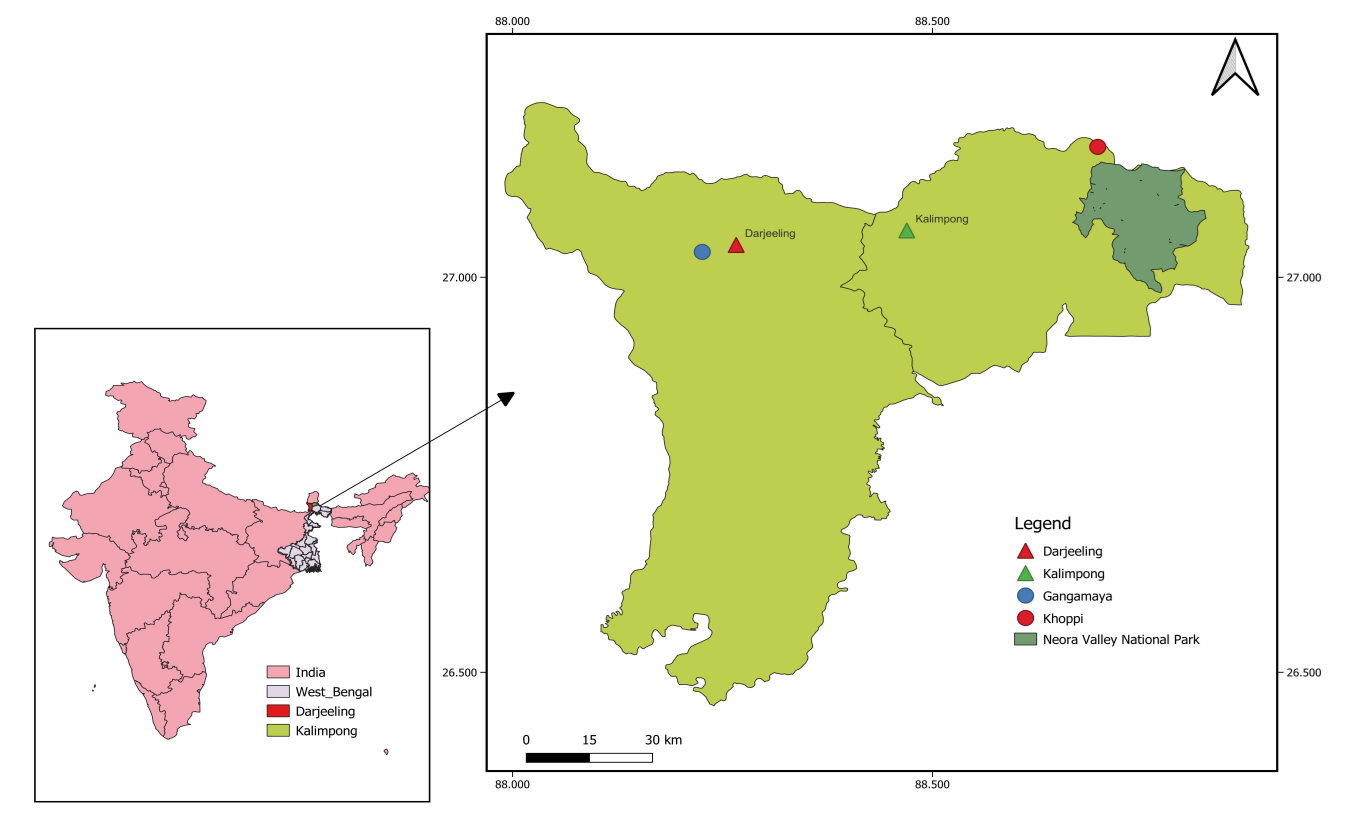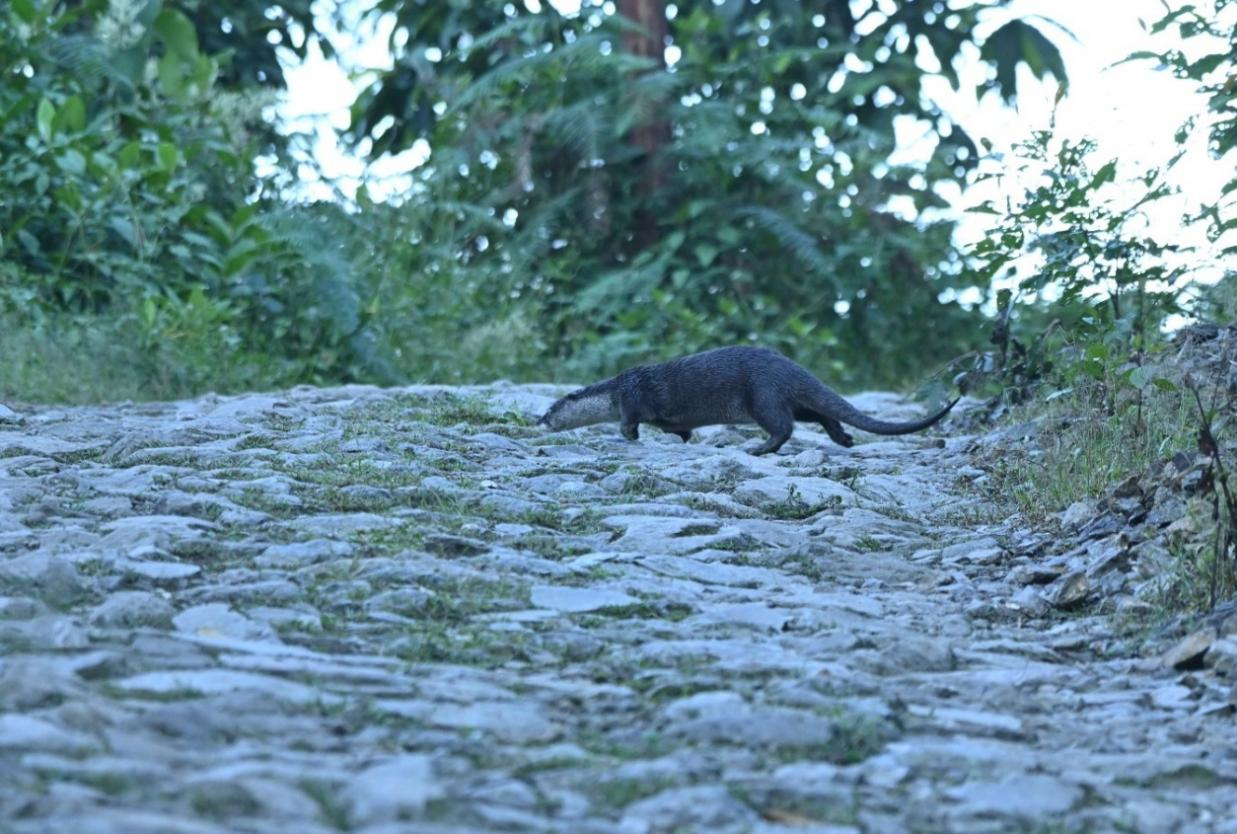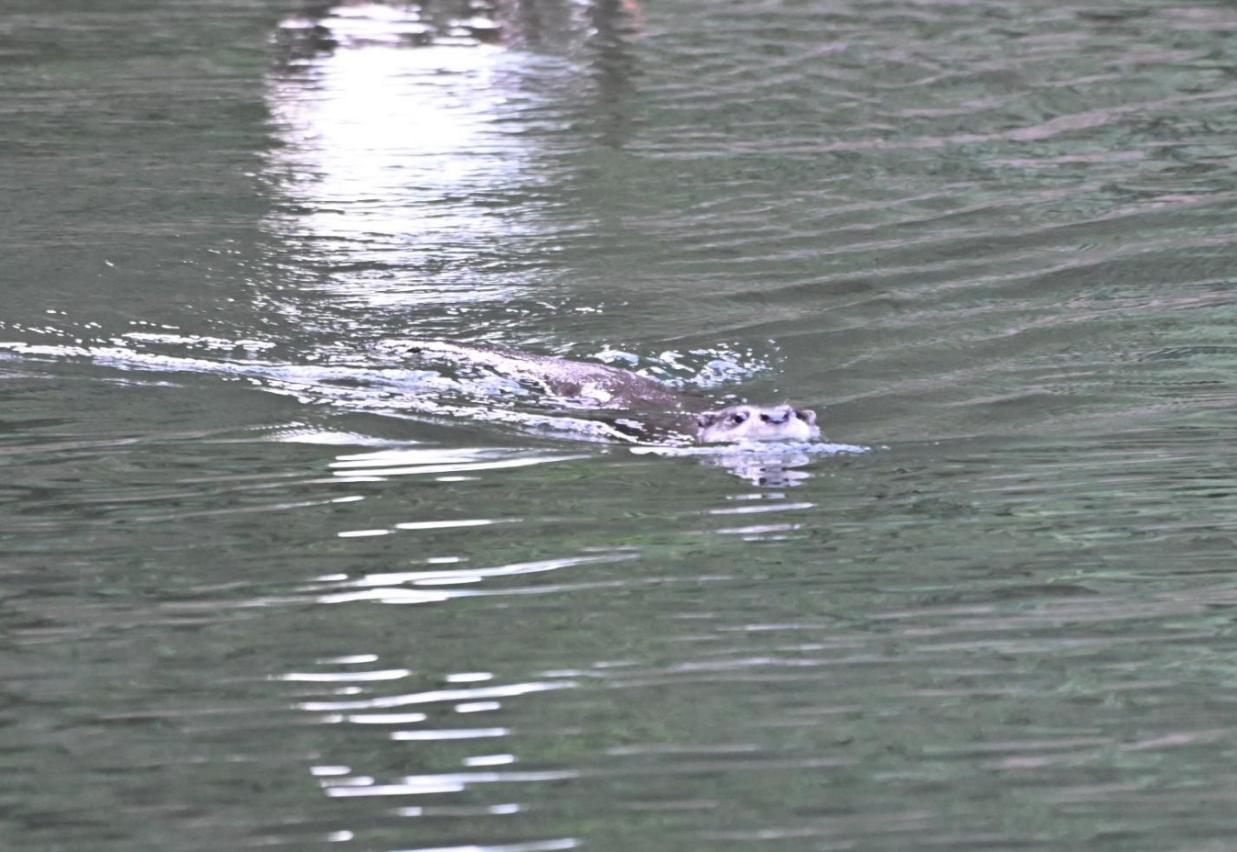IUCN/SSC Otter Specialist Group Bulletin

©IUCN/SCC Otter Specialist Group
Volume 41 Issue 3 (October 2024)
Citation: Sharma, S., Subba, A., Pradhan, G., and Chhetri, A. (2024). Photographic Evidence of Incidental Sightings of the Vulnerable Asian Small-Clawed Otter (Aonyx cinereus Illiger, 1815) in the Mixed Forest of Darjeeling and Kalimpong District as Part of Central Himalaya. IUCN Otter Spec. Group Bull. 41 (3): 140 - 153
Photographic Evidence of Incidental Sightings of the Vulnerable Asian Small-Clawed Otter (Aonyx cinereus Illiger, 1815) in the Mixed Forest of Darjeeling and Kalimpong District as Part of Central Himalaya
Shuvam Sharma1, Albina Subba1, Ganesh Pradhan2, and Abhijit Chhetri3*
1Department of Zoology, St. Joseph’s College, Darjeeling, India
2Enthusiast Wild Photographer, Bloomfield, Dali, Darjeeling, India
3Department of Microbiology, St. Joseph’s College, Darjeeling, PIN- 734104, India
*Corresponding Author Email: lamnorbu0@gmail.com
Received 5th November 2023, accepted 6th February 2024
Abstract: Direct incidental sightings and confirmed identification of A. cinereus was recorded for the first time with documented photographic evidence in the study areas. This new report of A. cinereus from subtropical humid type mixed forest (1294m a.s.l.) in District Darjeeling and from semi-temperate type forest (Elevation: 1924.35m a.s.l.) of District Kalimpong, in state West Bengal, India as a part of Bio-geographic Province 2C, Central Himalaya demonstrates that the distribution and ranging patterns of such vulnerable species is still patchy in India. The present study aims to fill up an immense knowledge gap on the distributional range of Asian small-clawed otter in human dominated vulnerable landscapes from the Central Himalaya.
Keywords: Aonyx cinereus, photographic evidence, temperate forest, Central Himalaya
INTRODUCTION
The ecosystem services offered by the mammals should inspire not only ecologists and conservationists of biodiversity but also to anyone concerned with sustainability of the biosphere. Mammals are considered to play an indispensable role in ecosystems functioning such as grazing, predation, and seed dispersal, and provide important benefits to humans in terms of food, recreation, and income, yet in spite of their unquestionable significance our understanding of them is still surprisingly sparse (Reeder et al., 2007; Schipper et al., 2008).
It is indeed a sad reflection on the researchers from this part of the world, that when many countries are preparing the Red-Data listings of threatened species from the perspective of conservation of nature and natural resources, being an integral part of biodiversity hotspot, most part of Bio-geographic Province 2C, Central Himalaya, still remain biologically unexplored.
The Asian small-clawed otter (Aonyx cinereus Illiger, 1815) is one of three species of river otters found in India while the others which are well documented from different regions of India include the Eurasian Otter (Lutra lutra Linnaeus, 1758) and the Smooth-coated Otter (Lutra perspicillata I. Geoffroy Saint-Hilaire, 1826), (Savage, 2022). Asian small-clawed otter (Aonyx cinereus) is a small semi-aquatic animal belonging to the mammalian order Carnivora and family Mustelidae (Hussain et al., 2011). They have distinctive hand-like front paws with reduced claws, well adapted for catching and handling small prey and a tapering tail which aids in propulsion for catching small vertebrate and invertebrate prey in shallow and murky water (Larivière, 2003; Hussain et al., 2011). The Asian small-clawed otter is reported to be the smallest otter among the 13 extant species of otters in the world (Harris, 1968; Foster-Turley and Santiapillai, 1990) rarely weighing more than 5 kg (Hussain et al., 2011). This species is a top carnivore and therefore plays an important role in the balance and processes of ecosystems. Thus, any disturbances in the distribution of the wild population of otters could significantly influence the overall spatiotemporal dynamics of river systems, and thereby impacting the beneficial ecosystem services that they provide (Gupta et al., 2016, 2020).
In the recent past this species is reported to be at risk of becoming regionally extinct in some areas, due to rapid population decline and loss of genetic variation, caused mainly by rampant habitat destruction, water pollution, depletion in prey species and direct exploitation by humans (Wright et al., 2015; Cuculescu-Santana et al., 2021). The species has been listed on CITES Appendix I since 2019 and the Red List of the International Union for the Conservation of Nature (IUCN) classifies the Small-clawed otter species as Vulnerable under criterion A2cde+3cde (Duplaix and Savage, 2018; Wright et al., 2021; Cuculescu-Santana et al., 2021) on the basis of its small and rapidly declining population. It is also estimated that the global population of the Asian Small-clawed otter has declined by >30% over the past 30 years (Pacifici et al., 2013).
The Asian small-clawed otter has a large distributional range. In the wild it is found extending from major river basins of Nepal to India in South Asia through Bangladesh, Myanmar, Thailand, and Indonesia in Southeast Asia to Philippines and Taiwan in the east and Southern China in the north (Hussain et al., 2011; Shrestha et al., 2021). It is reported to be found in diverse habitats, including coastal and freshwater wetlands, and rivers and lakes in forested areas (Wright et al., 2015; Cuculescu-Santana et al., 2017; Shrestha et al., 2021).
In India, the species of Aonyx is reported to occur in North India from the Himalayan foothills of Himachal Pradesh, West Bengal, Assam hill ranges as well as in South India, in the higher ranges of the hills in Coorg (Karnataka), Ashambu, Nilgiris and Palani hills (Tamil Nadu) and some places in Kerala (Pocock, 1941; Prater, 1948; Hussain, 1999). In recent years, its occurrence has been confirmed from the state of Odisha (Mohapatra et al., 2014; Mishra and Mohan, 2018), Sikkim (Khatiwara and Bhutia, 2020) and Chhattisgarh (Naidu et al., 2022) in India.
It has been observed that there is a gradual decline of otter populations in the wild across their range in Asia particularly related to the intensification of hunting and poaching (Aiyadurai et al., 2010; Datta et al., 2008; Gomez and Shepherd, 2019), which has led to infrequent sighting and even if spotted the observer are experiencing extremely small population. Amongst the other the threat posed by poaching is reported to be a significant one in many parts of India, and across Southeast Asia, and demands constant monitoring (Wright et al., 2015). The decline is projected to increase in the foreseeable future as a result of direct exploitation and emerging threats in different country related to the illegal trade in otters as pets in Asia which has become a major area of concern, with Indonesia, Japan and Thailand standing out as key players in this trade (Aadrean, 2013; Shepherd and Tansom, 2013; Gomez et al., 2016; Gomez and Bouhuys, 2018; Kitade and Naruse, 2018; Siriwat and Nijman, 2018; Gomez and Shepherd, 2019).
In the Indian context, illegal hunting of the species mostly for their pelts is prevalent in Northeastern part of India, where otters continue to be poached in Arunachal Pradesh and transported to Assam for sale at extremely high prices in the black market (Datta et al., 2008; Aiyadurai et al., 2010). Greater demands of pelts for trade in the colder regions of Northeast India, Tibet, and China are likely to lead to increased intensity of poaching and thus decreased conservation in its wild settings (Menzies and Rao, 2021). Thus, the Asian small-clawed otter once commonly found in numerous streams and wetlands of South and Southeast Asia is now restricted only to be found in a few protected areas (Hussain et al., 2011). In the present report, we explored the new distributional range of Asian Small-clawed otters from temperate forest of Kalimpong District, India and assessed the community-based perception on its conservation and future threats through informal conversations.
STUDY AREA
The present study of opportunistic sighting of small-clawed otter (Fig. 2) was documented from Khoppi Village (Elevation: 1924.35m a.s.l., Kalimpong District, West Bengal, India; Fig. 1), which is a forest fringe village situated in close proximity of Neora Valley National Park (NVNP). Established in 1881, NVNP is one of the oldest reserve forests in India and it covers a total area of 159.78km2 in 2017, falling under Biogeographic Province 2C, the Central Himalayas, as classified by Wildlife Institute of India (Mallick, 2010). NVNP as an integral part of the ecological trijunction with Sikkim and Bhutan is considered to be an ecologically important area with wide range of altitudinal variations with intact primary forest that has been short-listed in world heritage sites due to its rich Himalayan Biodiversity (Roy et al., 2012).


The second sighting (Fig. 3) was observed in Gangamaya as part of Darjeeling Hills at an elevation of 1294m a.s.l. (Fig. 1). Lying in the lower reaches of the foothills of the Darjeeling Hills, the study area Gangamaya experiences a humid subtropical type of climate. The summers are mostly hot and winters are cooler associated with the altitudes. In addition, the formation of mountains on all side may have profound effects on the humidity and the study area experience humidity from April to September with heavy rainfall during the monsoon. In the present study, an attempt was made to enlist the otter species in fringe village Khoppi in NVNP and in Gangamaya through direct accidental sightings during field trips especially conducted for bird watching.
RESULTS AND DISCUSSION
A Digital Camera (NIKON Z50 with a 270mm lens) was used for otter observation and photography and the Global Positioning System (GPS), was used for recording plot locations and measurement of plot distance. No population census was conducted across its home range in this study. However, the estimated population is found to be best placed in the band of 5 – 8 mature individuals as per informal conversations with the local people living near the river and adjoining lake. In Central Himalaya, Otter is locally known as “Paniko Oont”, which is a Nepali word concoction that literally translates to water camel.
A single animal was observed opportunistically on the morning of 15th October 2022, on the surface at the roadside at Fringe Village Khoppi in the Kalimpong district. In compliance with the managing policy of IUCN relevant guidelines, we have chosen not to disclose the precise GPS location of this Vulnerable species in this publication to avoid potential risks, such as attracting poachers and endangering local species which is frequently occurring in Northeastern part of India, and that is leading to many biological species to extinction. Direct observation of Asian small-clawed otter was made from the road mainly used by resident of Fringe Village Khoppi for their day-to-day purpose. Adjacent to the road the habitat was generally marshy, but at other times of the year a stream flows here, and within walking distance, there is also a lake preserved by local communities. The main habitat here is the temperate forest dominated by the vegetation of the species of the genera Castonoposis, Quercus and Engelhardtia etc., with nearby low-intensity agricultural land and villages. The identification of the live encountered animal was solely based on its external morphology as captured through incidental sightings. Interestingly, the close-up zoom in photographs on computer screen revealed that this individual is an Aonyx cinereus, because it has a brownish dorsal body colour, distinctive webbed feet, with the third and fourth digits markedly longer than second and fifth on each foot (Hussain et al., 2011).
Preliminary information collected from this area suggested that local people do not pay any particular attention to this, however, some of the local people from the fringe Village Khoppi within the middle of NVNP were more or less aware of the occurrence of this ecologically important animal. In addition, there is no clue as such of any illegal poaching as indicated by respondents through informal conversation, however, they do strongly agree and support the conservational need of this animal in their respective locality. The highlight of the present documentation as accrued by speaking to local community respondents indicates that the local people can be persuaded by some initiatives from the educational or any other conservational institutions for preservation and management strategies of this animal in their natural habitat.
As species like A. cinereus, are rare; they deserve earliest attention for their conservation in the study areas through proper planning. The management and conservation strategies are important in the present context of the fringe village Khoppi as “habitat loss is regarded as one of the greatest threats for biodiversity loss” (Wilcove et al, 1998). In the study area, some of the factors may play an important role in the overall management of A. cinereus with the continuous pressure of high settlement density with increasing agricultural and pastoralist practices as the study area is dominated by people who are mostly agriculturists, and the documented sites lies close proximity to NVNP. It is well known, in such human dominated spaces domestication of carnivore species like Canis familiaris (dogs) and Felis catus (cats) for safeguarding their resources is perhaps quite natural (Driscoll et al., 2009). What is not known to local people, that as reported by the previous workers that domestic dogs are apparently the most abundant carnivore globally and is perceived as a severe threat and vulnerable to the local wildlife (Daniels and Bekoff, 1989a; 1989b) and this may significantly contribute to the loss of species.
The Himalayas are essentially a mountainous range in Asia, with 24% coverage of terrestrial land surface and home to about 20% of the global population, mountain ecosystems are one of the unique in nature (FAO 2015; Xu et al., 2019; Sharma and Chhetri, 2021). The mountains possess a diversity of microclimatic conditions that generates a variety of vegetation and ecological conditions which are of global significance owing to the extreme variations in mountainous biophysical system such as elevation, slope and aspects (Antonelli et al., 2018; Huang et al., 2019; Sharma and Chhetri, 2021). Climate change that we are now perceiving is believed to be one of the biggest environmental challenges of the twenty first century with a detrimental consequence to mountain ecosystem (Chettri et al., 2018; Roy et al., 2024). Mountains are typically exposed to multiple hazards, and it represents an important area for detecting climate change and assessing climate change impacts (Nogues-Bravo et al., 2008; Kohler et al., 2010). Threats to biodiversity are numerous but the prevailing climate change trend in the Himalayas including the Central Himalaya are bringing alarming signal of biodiversity loss leading to vulnerability and negatively affecting the biodiversity of the region (Chettri et al., 2018).
At the present time, knowledge of changing climate from the Central Himalaya is scanty and scattered. The smooth-coated otter (Lutrogale perspicillata); the Asian small-clawed otter (Aonyx cinereus) (Duplaix and Savage, 2018); and the Eurasian otter (Lutra lutra) (Jamwal et al., 2016), which are also found in the Himalayan region have been species modelled to determine the global vulnerability index and to evaluate the effects of global climate change on the future distribution of the Eurasian otter particularly in Europe (Cianfrani et al., 2011; 2018). However, in the context of the Himalayan region it has been in recent past predicted through the technique of Climate Change Vulnerability Assessment (CCVA), future climate and land use alterations will exert an overall detrimental effect on the geographical range of three otter species in the Himalaya, contributing to increased vulnerability index (Jamwal et al., 2022). It has already been noted through modelling species response to climate change, that all three species in the Himalaya with respect to both climate and land use future alterations might be causing these species to undergo moderate to severe shrinking and shift in their distribution under 2050 global change scenarios (Jamwal et al., 2022). A. cinereus has been reported to have environmental preferences, where forest habitats being the prime and any fluctuation in temperature and land use modifications are predicted to exert the most vulnerable effects on A. cinereus (Jamwal et al., 2022). In the present context, mountain geological formations in the Central Himalaya are fragile and ecosystems are depleting fast because of critical drivers of climate change and biodiversity loss. The ecosystem in the Central Himalaya is slowly losing its resilience due to homogenization and fragmentation of landscapes. Therefore, impending threat posed by changing climate to the distribution of A. cinereus is well perceived in Central Himalaya and are in concordance to the predictions made by Climate Change Vulnerability Assessment on three otter species occurring in the Himalayan region (Jamwal et al., 2022).
In the wider context of otter conservation, it is also important to note that climate change in the mountains may bring about vulnerable effects on the overall carrying capacity. Global climate change can exert its strong effects on otter’s, reproductive patterns, change on distribution including prey base, increased incidence of emerging and reemerging infectious diseases and eventually it may lead to genetic alteration that may increase or decrease the overall fitness. Within the purview of future study, it would be desirable to carry out vulnerability assessments that are critical in mountain ecosystems, which are one of the most sensitive ecosystems to global climate change (Beniston, 2003).
Arguably, the Central Himalayan region could be one of the critical otter conservation strongholds for conservation biologists and policy-makers at large to manage this vulnerable species in human modified landscapes. At the present time, faced with obvious multifaceted difficulties with respect to scarcity of in situ baseline data in Darjeeling and Kalimpong Districts, population assessments and determination of potential threats of this vulnerable indicator species in several prime otter habitats periodically can be prerequisite. In addition to traditional field survey, eDNA-based approaches such as eDNA metabarcoding analysis are also being used for better species resolution in assessing freshwater otter biodiversity in the fragile and challenging Trans-Himalayan ecosystem (Jamwal et al., 2023). Thus, new molecular approaches could be applied in future studies to delineate the taxa from Central Himalaya. Further, in order to ensure the conservation of otter, it would be desirable to study the resident flora and fauna contained therein which constitute the essential and fundamental components of the prey base for a top carnivore.
The otter is considered to be a keystone aquatic predator and indicator species of healthy fresh water ecosystems (Kruuk, 2006; Ruiz-Olmo et al., 1998; Jamwal et al., 2022). Research should aim to minimise anthropogenic disturbances in the proximity of its habitat as otters are highly vulnerable species, sensitive to habitat loss and water pollution (Kruuk, 2006; Ruiz-Olmo et al., 1998). Rapid habitat fragmentation, contamination of water and illegal trade are responsible for the recent decline in otter populations throughout Asia and the Himalayan region (de Silva, 2011; Duplaix and Savage, 2018; Loy et al, 2021; Loy et al., 2022; Jamwal et al., 2022). Further, emphasis should be laid on otter movements through GPS collaring otter or by using camera trapping study. Prime otter habitat which includes both the terrestrial, lakes and riverine forest habitats must be protected as core zone and critical conservation areas to restrict human landscape modifications. One of the key risk factors that may impact the survival of otter in riverine forest system depends on an appropriate quality of water and the prey base present therein. In general, species of otter are characteristics for carrying out movement and predation on free-flowing freshwater rivers. Further, it is also equally important to mention here, that an indiscriminate illegal fishing activities including electrofishing and poison fishing will negatively affect the abundance of this species inevitably. These destructive and hazardous practices will not only lead to decrease in food sources in riverine system but it will also significantly decrease the already extremely small population of otter. In a different context, we have registered a few events of electrofishing and poison fishing in the temperate riverine systems of Central Himalaya. In case of poison fishing, piscicidal plant extracts and salts of heavy metals especially copper sulphate, silver nitrate, mercuric sulphate, bleaching powder, DDT and parathion are used by the local people and addition of these concentrated substances in the water is detrimental to all aquatic life forms including otter. Many of these chemicals are cheap and effective that are easily available in the market, but the local people are completely unaware of the catastrophic health risks these chemical contaminants pose. Hence, it should be noted that these detrimental practices of fishing by the local people in the backdrop of insufficient scientific knowledge on the appropriate dosages of these hazardous chemicals which are vulnerable to environmental change, consequently this cannot be rule out in the present perspective of otter conservation. In addition, research on toxicological experiments is required to investigate the synergistic and long-term effects of chemical contaminants on successive life stages and sexual development of otter to highlight those areas where these contaminants are most likely to exceed the level that this indicator species may withstand. Thus, breeding and non-breeding habitats with seasonal variations must be identified if the conservation of otter species is to be made effective. Analysis on carnivore intraguild relations should be a top priority especially for management and conservation actions chiefly in these areas to help us predict whether there is a conclusive habitat overlap between otter and on other large carnivores which is fundamental to their ecology and conservation as the otter range continues to expand.
Although our knowledge of the of otter poaching in the Central Himalaya for economic reasons or meat consumption is poorly represented and far from complete, we know there is an existing active trade in otter pelts and as a pet in many parts of India, and across Southeast Asia (Wright et al., 2015). Illegal trading of otter pelts from Central Himalaya is however unstudied at the present time, unthinking of such possibilities in the prevalence of illegal market for otter especially in the Northeastern part of India is also of concern. Such practices even at a small level may bring unforeseen impacts on the overexploited Asian Small-Clawed otter. One of the most prompt fundamental solutions is patrolling with field researchers that needs to be strengthened and upscaled to reduce dangers of otter hunting and poaching for economic reasons. Patrolling can also curb other illegal activities taking place in otter habitats and more refined measures can be adopted later, as we gather more and more information on understanding of the species. As study revealed that most of the local people living in proximity to Central Himalaya belong to low economic strata and are mostly agro-pastoralists in livelihood occupation. Thus, mountain ecosystem plays an important extrinsic and intrinsic role in generating a diverse range of livelihood activities for any one household. Therefore, community awareness shares an integral and indispensable relationship to any successful conservation program. In this context, there is an urgent need to educate people through effective community-based conservation policies such as frequent sensitization workshops about the biology and ecology of otter especially in areas where anthropogenic habitat disturbances, such as construction projects like hydel power dam, broad roadways constructions are rising thereby leading to indiscriminate fragmentation of contiguous forest tract. In the context of environmental degradation with respect to deforestation, land sliding, and large-scale downstream flooding, coupled with inappropriate mega man-made environmental collapse due to rampant construction of heavy power hydel dam and railway tunnels are ravaging the delicate equilibrium in the fragile Bio-geographic Province 2C, Central Himalaya. To lose such a valuable bioresource in terms of flora and fauna from the Himalayas, conservationists, biologists, and indigenous people have expressed growing apprehension about the rapid degradation in the Himalayan environment. A clear indication of such perception has been noticed and experienced during the recent flash flood catastrophe that has drastically resulted in the loss of flora, fauna and aquatic life equally in the mountain part of Sikkim and West Bengal, India.
Other studies have identified that human interference in wildlife natural habitats through anthropogenic change has led to competition for shared resources, resulting in heterogenous conflict as these factors are believed to hinder the dispersal ability of wildlife in their home ranges especially in forest fringes (Karanth and Kudalkar 2017; Sharma et al., 2022). Concurrently, through participatory biodiversity conservation programmes, awareness on the importance of otter conservation, existing legal framework on Wild Life Protection Act, fines and penalties on wildlife poaching, and trading of wildlife species mainly otter in India should be augmented. These are some of the reasons why it is important to convince local communities through any means, especially regarding the management of environmental resources to protect the vulnerable species A. cinereus. Despite the urgency to mitigate the impending threat, baseline information on ecology of A. cinereus particularly in Central Himalaya is seriously wanting. In order to ascertain these dynamics, it is extremely important at this point to carry out further scientific research and conservation action particularly in man altered landscape in Central Himalaya for continued positive outcomes.
CONCLUSIONS
In view of the incidental sighting of the spontaneous animal, the present study contributes important information to the understanding of A. cinereus distribution and status in forest of Kalimpong and Darjeeling District, India. A bird’s eye view of the literature using various digital search engine with key words otter and library resources reveals that no existing literature information is available on distributional pattern of this species from this part of India. This study presents the documentation of the first evidence of A. cinereus from the forest fringe village Khoppi situated in close proximity of Neora Valley National Park and in Gangamaya in Darjeeling hills. While an assessment of population distribution of small clawed otter in the study sites was beyond the scope of this study. However, due to high diversity of trees species and animals at all taxonomic levels, the NVNP and Darjeeling hills would provide an ideal location to carry out further research on otters. In general, for the plan conservation measures the present study demands further exhaustive reassessment and management recommendation urgently to advance our understanding with respect to the biodiversity of the species, overall niche characteristics and water quality assessment to ensure the water in the lake and riverine systems are not polluted.
Acknowledgements: We want to thank Mr. Karma Leki, Chief Forestry Officer of Trashigang Forest Division, Department of Forest and Park Services, for his continuous support and motivation. We are also indebted to the staff of Trashigang Forest Division for information sharing. Mr. Rinchen Choda of Toetsho Beat, Mr. Phurpa Wangdi of Radhi Range and Mr. Tshering Choephel of Bumdeling Wildlife Sanctuary, is also well acknowledged for allowing us to use their photographs of Smooth-coated otter, Eurasian otter and Small-clawed otter. We express our sincere gratitude to Melissa Savage (PhD), University of California, Los Angeles, USA for correct species indentification. Further, we are extremely grateful to all the anonymous reviewers for their comments and suggestions in improving the quality of this manuscript.
REFERENCES
Aadrean, A. (2013). An Investigation of Otters Trading as Pet in Indonesian Online Markets. Jurnal Biologika 2(1): 1–6. https://jurnalbiologika.wordpress.com/wp-content/uploads/2013/12/aadrean-2013.pdf
Aiyadurai, A., Singh, N.J., Milner-Gulland, E.J. (2010). Wildlife hunting by indigenous tribes: a case study from Arunachal Pradesh, north-east India. Oryx 44(4): 564-572. https://doi.org/10.1017/S0030605309990937
Antonelli, A., Kissling, W.D., Flantua, S.G., Bermudez, M.A., Mulch, A., Muellner-Riehl, A.N., Fritz, S.A. (2018). Geological and climatic influences on mountain biodiversity. Nature Geoscience, 11(10), 718– 725. https://doi.org/10.1038/s41561-018-0236-z
Beniston, M. (2003). Climatic change in Mountain regions: A review of possible impacts. In H. Diaz (Ed.), Climate variability and change in high elevation regions: Past, present & future (pp. 5–31). Springer. https://doi.org/10.1023/A:1024458411589
Chettri, N., Tsering, K., Shrestha, A., Sharma, E. (2018). Ecological vulnerability to climate change in the mountains: a case study from the Eastern Himalayas. Chapter 29 (Vol 2) pp. 707–721 in: P Das, S Bera (Eds) The Plant Diversity in the Himalaya Hotspot Region. Bishen Singh Mahendra Pal Singh, Dehradun, India. ISBN: 9788121109468
Cianfrani, C., Broennimann, O., Loy, A., Guisan, A. (2018). More than range exposure: Global otter vulnerability to climate change. Biological Conservation, 221, 103–113. https://doi.org/10.1016/j.biocon.2018.02.031
Cianfrani, C., Lay, G. L., Maiorano, L., Satizábal, H.F., Loy, A., Guisan, A. (2011). Adapting global conservation strategies to climate change at the European scale: The otter as a flagship species. Biological Conservation, 144(8), 2068–2080. https://doi.org/10.1016/j.biocon.2011.03.027
Cuculescu-Santana, M., Mason, J., Purchase, K., Mckie, R. (2021). Outdoor Enclosure Use and Behaviour of Adult and Cub Asian Small Clawed Otters Aonyx cinereus in Summer and Winter. IUCN Otter Spec. Group Bulletin, 38 (1): 3 -27 https://www.iucnosgbull.org/Volume38/Cuculescu_et_al_2021.html
Daniels, T.J., Bekoff, M. (1989a). Feralization: The making of wild domestic animals. Behav Processes 19(1-3):79-94. PMID: 24895903. https://doi.org/10.1016/0376-6357(89)90032-6
Daniels, T.J., Bekoff, M. (1989b). Population and Social Biology of Free-Ranging Dogs, Canis familiaris. Journal of Mammalogy, 70(4): 754–762. https://doi.org/10.2307/1381709.
Datta, A., Naniwadekar, R., Anand, M.O. (2008). Occurrence and conservation status of small carnivores in two protected areas in Arunachal Pradesh, north-east India. Small Carnivore Conservation 39: 1-10. https://www.biodiversitylibrary.org/page/48583086
de Silva, P.K. (2011). Status of Otter Species in the Asian Region Status for 2007. Proceedings of Xth International Otter Colloquium, IUCN Otter Spec. Group Bull., 28A: 97 - 107 https://www.iucnosgbull.org/Volume28A/de_Silva_2011.html
Driscoll, C.A., Macdonald, D.W., and O’Brien, S.J. (2009). From wild animals to domestic pets, an evolutionary view of domestication. PNAS, 106: 9971-9978. https://doi.org/10.1073/pnas.0901586106
Duplaix, N., and& Savage, M. (2018). The Global Otter Conservation Strategy. IUCN/SSC Otter Specialist Group. https://escholarship.org/uc/item/12d608qf
FAO (2015). Mapping the vulnerability of mountain peoples to food insecurity. Food and Agriculture Organization of the United Nations. ISBN: 978-92-5-108993-4 https://openknowledge.fao.org/server/api/core/bitstreams/fc51a31f-4d11-45da-a9f3-5d44277ab231/content
Foster-Turley, P., Santiapillai, C. (1990). Action plan for Asian otters, In Foster-Turley, P., Macdonald, S., and Mason, C. (Eds). Otters, an action plans for their conservation (Eds.) IUCN/SSC, Otter Specialist Group. IUCN, Gland. 126 pp.
Gomez, L., Bouhuys, J. (2018). Illegal Otter Trade in Southeast Asia. TRAFFIC, Petaling Jaya, Selangor, Malaysia. https://www.traffic.org/site/assets/files/5228/seasia-otter-report.pdf
Gomez, L., Leupen, B.T.C., Theng, M., Fernandez, K., Savage, M. (2016). Illegal Otter Trade: An analysis of seizures in selected Asian countries (1980– 2015). TRAFFIC, Petaling Jaya, Selangor, Malaysia. https://www.traffic.org/site/assets/files/2402/illegal-otter-trade-asia.pdf
Gomez, L., Shepherd, C.R. (2019). Stronger International Regulations and Increased Enforcement Effort is needed to end the Illegal Trade in Otters in Asia. IUCN Otter Spec. Group Bulletin 36 (2): 71 – 76. https://www.iucnosgbull.org/Volume36/Gomez_Shepherd_2019.html
Gupta, N, Johnson, JA, Sivakumar, K and Mathur, VB (2016). The Perilous Voyage of Indian Himalayan ‘Ambassadors’ amidst Anthropogenic Pressures and changing Climatic Variables. IUCN Otter Spec. Group Bull., 33 (1): 33 – 36 https://www.iucnosgbull.org/Volume33/Gupta_et_al_2016.html
Gupta, N., Tiwari, V., Everard, M., Everard, M., Savage, M., Hussain, S.A., Chadwick, M.A., Johnson, J.A., Nawab, A., Belwal., V.K. (2020). Assessing the distribution pattern of otters in four rivers of the Indian Himalayan biodiversity hotspot. Aquat Conserv Mar Freshw Ecosyst. 30(3):601–610. https://doi.org/10.1002/aqc.3284
Harris, C.J. (1968). Otters: A study of the Recent Lutrinae. London. Weidenffeld and Nicolson, United Kingdom. 307 pp. ISBN: 978-0297767497
Huang, S., Meijers, M.J., Eyres, A., Mulch, A., Fritz, S.A. (2019). Unravelling the history of biodiversity in mountain ranges through integrating geology and biogeography. Journal of Biogeography, 46(8), 1777–1791. https://doi.org/10.1111/jbi.13622
Hussain, S.A. (1999). Status of otter conservation in India. Environmental Information System Bulletin: Wildlife and Protected Areas, Mustelids, Viverrids and Herpestids of India 2: 92-97. https://archive.org/details/MustelidsViverridsIndia
Hussain, S.A., Gupta, S.K., de Silva, P.K. (2011). Biology and Ecology of Asian Small-Clawed Otter Aonyx cinereus (Illiger, 1815): A Review. IUCN Otter Spec. Group Bulletin 28 (2): 63 – 75. https://www.iucnosgbull.org/Volume28/Hussain_et_al_2011.html
Jamwal, P.S., Bruno, A., Galimberti, A., Magnani, D., Casiraghi, M., Loy, A. (2023). Environmental DNA revealed high accuracy in detection of the Eurasian otter in Himalaya. Aquatic Conservation: Marine and Freshwater Ecosystems, 33(11): 1309–1320. https://doi.org/10.1002/aqc.4010
Jamwal, P.S., Di Febbraro, M., Carranza, M.L., Savage, M., Loy, A. (2022). Global change on the roof of the world: Vulnerability of Himalayan otter species to land use and climate alterations. Diversity and Distributions, 28: 1635–1649. https://doi.org/10.1111/ddi.13377
Jamwal, PS, Takpa, J, Chandan, P and Savage, M (2016). First Systematic Survey for Otter (Lutra lutra) in Ladakh, Indian Trans Himalayas. IUCN Otter Spec. Group Bull. 33 (1): 79 - 85 https://www.iucnosgbull.org/Volume33/Jamwal_et_al_2016.html
Karanth, K.K., Kudalkar, S. (2017). History, location, and species matter: insights for human–wildlife conflict mitigation from India. Human dimensions of Wildlife, 22(4): 331–346. https://doi.org/10.1080/10871209.2017.1334106
Khatiwara, S., Bhutia, K.C. (2020). A Distribution Survey for Otters in Sikkim, India. IUCN Otter Spec. Group Bull. 37 (4): 212 – 218 https://www.iucnosgbull.org/Volume37/Khatiwara_Bhutia_2020.html
Khoo, M., Basak, S., Sivasothi, N., De Silva, P.K., Reza Lubis, I. (2021). Lutrogale perspicillata. The IUCN Red List of Threatened Species. https://www.iucnredlist.org/species/12427/164579961#external-data.
Kitade, T., Naruse, Y. (2018). Otter Alert: a rapid assessment of illegal trade and booming demand in Japan., TRAFFIC, Japan. https://www.traffic.org/site/assets/files/11196/otter-alert-vfinal-web-100.pdf
Kohler, T., Giger, M., Hurni, H., Ott, C., Wiesmann, U., von Dach, S.W., Maselli, D., (2010). Mountains and climate change: a global concern. Mountain Research and Development, 30 (1), 53–55. https://doi.org/10.1659/MRD-JOURNAL-D-09-00086.1.
Kruuk, H. (2006). Otters: Ecology, behaviour and conservation. Oxford University Press. ISBN: 9780198565871 https://doi.org/10.1093/acprof:oso/9780198565871.001.0001
Larivière, S. (2003). Amblonyx cinereus. Mamm. Species, 720: 1-5. https://doi.org/10.1644/0.720.1
Loy, A., Jamwal, P.S., Hussain, S.A. (2021). Lutra lutra (Green Status assessment). The IUCN Red List of Threatened Species 2021: e. T12419A1241920221. https://nc.iucnredlist.org/redlist/content/attachment_files/Green_Status_Supplementary_Information_12419.pdf
Loy, A., Kranz, A., Oleynikov, A., Roos, A., Savage, M., Duplaix, N. (2022). Lutra lutra (amended version of 2021 assessment). The IUCN Red List of Threatened Species 2022: e.T12419A218069689.
https://dx.doi.org/10.2305/IUCN.UK.2022-2.RLTS.T12419A218069689.en
Mallick, J.K. (2010). Status of Red Panda Ailurus fulgens in Neora Valley National Park, Darjeeling District, West Bengal, India. Small Carnivore Conservation, 43: 30-36. https://smallcarnivoreconservation.com/index.php/sccg/issue/view/279/81
Menzies, R.K., Rao, M. (2021). Incidental Sightings of the Vulnerable Asian Small-Clawed Otter (Aonyx cinereus) in Assam, India: Current and Future Threats. IUCN Otter Spec. Group Bulletin 38 (1): 36 – 42 https://www.iucnosgbull.org/Volume38/Menzies_Rao_2021.html
Mishra, S.R., Mohan, M. (2018). First Photographic Documentation and Distribution of the Asian Small-Clawed Otter Aonyx cinereus in Similipal Tiger Reserve, Odisha, India. IUCN Otter Spec. Group Bulletin 35 (4): 186 – 192. https://www.iucnosgbull.org/Volume35/Mishra_et_al_2018.html
Mohapatra, P.P., Palei, H.S., Hussain, S.A. (2014). Occurrence of Asian small-clawed otter Aonyx cinereus (Illiger, 1815) in Eastern India. Current Science 107(3) : 367-370. https://www.currentscience.ac.in/Volumes/107/03/0367.pdf
Naidu, R., Trivedi, K., Mandavia, A., Singh, S., Bharos, A.M.K., Jadeja, S., Kshirsagar, N. (2022). Distribution of the Asian Small-Clawed Otter (Aonyx cinereus) in Chhattisgarh, India. IUCN Otter Spec. Group Bulletin 39 (3): 171 – 178. https://www.iucnosgbull.org/Volume39/Naidu_et_al_2022.html
Nogues-Bravo, D., Araujo, M. B., Romdal, T., Rahbek, C. (2008). Scale effects and human impact on the elevational species richness gradients. Nature, 453(8): 216–220. https://doi.org/10.1038/nature06812
Pacifici, M., Santini, L., Di Marco, M., Baisero, D., Francucci, L., Grottolo Marasini, G., Visconti, P., Rondinini, C. (2013). Generation length for mammals. Nature Conservation 5: 87–94. https://doi.org/10.3897/natureconservation.5.5734
Pocock, R.I. (1941). The Fauna of British India, including Ceylon and Burma. Carnivora (continued from volume I), suborders Aeluroidea (part) and Arctoidea. Taylor and Francis, Ltd., London. 503 pp.. Taylor & Francis, Ltd., London, UK.
Prater, S. (1971). The Book of Indian Animals. Bombay Natural History Society, Bombay, India. ISBN: 9780195621693
Reeder, D.M., Helgen, K.M., Wilson, D. (2007). Global trends and biases in new mammal species discoveries. Museum of Texas Tech University, Occasional Papers 269: 1–35. https://www.biodiversitylibrary.org/part/281449
Roy, A., Kumar, S., Rahaman, M. (2024). Exploring climate change impacts on rural livelihoods and adaptation strategies: Reflections from marginalized communities in India. Environmental Development, 49, 1-20. https://doi.org/10.1016/j.envdev.2023.100937
Roy, U.S., Banerjee, P., Mukhopadhyay, S.K. (2012). Study on avifaunal diversity from three different regions of North Bengal, India. Asian Journal of Conservation Biology 1(2):120-129. http://ajcb.in/journals/full_papers_dec_12/10_Roy%20%20et%20al_AJCB_1_2_120-129.pdf
Ruiz-Olmo, J., Calvo, A., Palazón, S., Arqued, V. (1998). Is the Otter a bioindicator? Galemys, 10: 227–237. https://www.researchgate.net/publication/235330186
Savage, M. (2022). Otters in Northeast India: A Review of the Sparse Available Information. IUCN Otter Spec. Group Bulletin 39 (2): 81 – 89. https://www.iucnosgbull.org/Volume39/Savage_2022.html
Schipper, J., Chanson, J.S., Chiozza, F., Cox, N.A., Hoffmann, M., Katariya, V., Lamoreux, J., Rodrigues, A.S., Stuart, S.N., Temple, H.J., Baillie, J., Boitani, L., Lacher, T.E. Jr., Mittermeier R.A., Smith, A.T., Absolon, D., Aguiar, J.M., Amori, G., Bakkour, N., Baldi, R., Berridge, R.J., Bielby, J., Black, P.A., Blanc, J.J., Brooks, T.M., Burton, J.A., Butynski, T.M., Catullo, G., Chapman, R., Cokeliss, Z., Collen, B., Conroy, J., Cooke, J.G., da Fonseca, G.A., Derocher, A.E., Dublin, H.T., Duckworth, J.W., Emmons, L., Emslie, R.H., Festa-Bianchet, M., Foster, M., Foster, S., Garshelis, D.L., Gates, C., Gimenez-Dixon, M., Gonzalez, S., Gonzalez-Maya, J.F., Good, T.C., Hammerson, G., Hammond, P.S., Happold, D., Happold, M., Hare, J., Harris, R.B., Hawkins, C.E., Haywood, M., Heaney, L.R., Hedges, S., Helgen, K.M., Hilton-Taylor, C., Hussain, S.A., Ishii, N., Jefferson, T.A., Jenkins, R.K., Johnston, C.H., Keith, M., Kingdon, J., Knox, D.H., Kovacs, K.M., Langhammer, P., Leus, K., Lewison, R., Lichtenstein, G., Lowry, L.F., Macavoy, Z., Mace, G.M., Mallon, D.P., Masi, M., McKnight, M.W., Medellín, R.A., Medici, P., Mills, G., Moehlman, P.D., Molur, S., Mora, A., Nowell, K., Oates, J.F., Olech, W., Oliver, W.R., Oprea, M., Patterson, B.D., Perrin, W.F., Polidoro, B.A., Pollock, C., Powel, A., Protas, Y., Racey, P., Ragle, J., Ramani, P., Rathbun, G., Reeves, R.R., Reilly, S.B., Reynolds, J.E. 3rd., Rondinini, C., Rosell-Ambal, R.G., Rulli, M., Rylands, A.B., Savini, S., Schank, C.J., Sechrest, W., Self-Sullivan, C., Shoemaker, A., Sillero-Zubiri, C., De Silva, N., Smith, D.E., Srinivasulu, C., Stephenson, P.J., van Strien, N., Talukdar, B.K., Taylor, B.L., Timmins, R., Tirira, D.G., Tognelli, M.F., Tsytsulina, K., Veiga, L.M., Vié, J.C., Williamson, E.A., Wyatt, S.A., Xie, Y., Young, B.E. (2008). The status of the world's land and marine mammals: diversity, threat, and knowledge. Science, 322(5899): 225-30. https://doi.org/10.1126/science.1165115
Sharma, E., Chettri, N. (2021). Biodiversity Conservation and Ecosystem Services in the Hindu Kush Himalaya. Journal of Graphic Era University, 9(1): 1–18. https://doi.org/10.13052/jgeu0975-1416.911
Sharma, P., Gurung, J., Wangchuk, K., Uddin, K., Chettri, N. (2022). Changing Landscape and Escalating Human-Wildlife Conflict: Introspection from a Transboundary Landscape. In: Sahana, M., Areendran, G., Raj, K. (eds) Conservation, Management and Monitoring of Forest Resources in India. Springer, Cham. https://doi.org/10.1007/978-3-030-98233-1_17
Shepherd, C.R., Tansom, P. (2013). Seizure Of Live Otters in Bangkok Airport, Thailand. IUCN Otter Spec. Group Bulletin, 30 (1): 37 – 38 https://www.iucnosgbull.org/Volume30/Shepherd_Tansom_2013.html
Shrestha, M.B., Shrestha, G., Reule, S., Oli, S., Tripathi, D.M., Savage, M. (2021). Otter Survey along the Sanibheri River and its Tributaries, the Pelma and Utterganga Rivers in Rukum District, Western Nepal IUCN Otter Spec. Group Bulletin 38 (5): 267 – 278 https://www.iucnosgbull.org/Volume38/Shrestha_et_al_2021a.html
Siriwat, P., Nijman, V. (2018). Illegal pet trade on social media as an emerging impediment to the conservation of Asian otters’ species. Journal of Asia-Pacific Biodiversity 11 (4): 469-475. https://doi.org/10.1016/j.japb.2018.09.004
Wilcove, D. S., Rothstein, D., Dubow, J., Phillips, A., Losos, E. (1998). Quantifying threats to Imperilled species in the United States. BioScience 48 (8): 607-615. https://doi.org/10.2307/1313420
Wright, L., de Silva, P.K., Chan, B., Reza Lubis, I., Basak, S. (2021). Aonyx cinereus. The IUCN Red List of Threatened Species e.T44166A164580923. https://dx.doi.org/10.2305/IUCN.UK.2021-3.RLTS.T44166A164580923.en
Xu, J., Badola, R., Chettri, N., Chaudhary, R. P., Zomer, R., Pokhrel, B., Hussain, S. A., Pradhan, S., Pradhan, R. (2019). Sustaining biodiversity and ecosystem services in the Hindu Kush Himalaya. In: Wester, P., Mishra, A., Mukherji, A. & Shrestha, A. B., (eds) The Hindu Kush Himalaya Assessment: Mountains, Climate Change, Sustainability and People. Springer International Publishing, pp. 127–165. https://doi.org/10.1007/978-3-319-92288-1_5
Résumé: Preuves Photographiques d’Observations Fortuites de la Loutre Cendrée (Aonyx cinereus Illiger, 1815), Espèce Vulnérable, dans la Forêt Mixte de Darjeeling et du District de Kalimpong Situé dans l’Himalaya Central
Des observations directes fortuites et une identification confirmée de la loutre cendrée (A. cinereus) ont été enregistrées pour la première fois avec des preuves photographiques documentées dans les zones d’étude. Ce nouveau rapport d’A. cinereus concerne une forêt mixte de type subtropical humide (altitude : 1.294 m au-dessus du niveau de la mer) dans le district de Darjeeling et une forêt de type semi-tempéré (altitude : 1.924,35 m au-dessus du niveau de la mer) du district de Kalimpong, dans l’État du Bengale occidental au niveau de la province Bio-géographique 2C de l’Himalaya central en Inde. Ce rapport démontre que la répartition et les schémas de distribution de ces espèces vulnérables sont encore variables en Inde. La présente étude vise à combler un immense manque de connaissances concernant l’aire de répartition de la loutre cendrée dans les paysages vulnérables de l’Himalaya central dominés par l’homme..
Revenez au dessus
Resumen: Evidencia Fotográfica de Avistajes Incidentales de la Vulnerable Nutria de Uñas Pequeñas Asiática (Aonyx cinereus Illiger, 1815) en el Bosque Mixto de los Distritos Darjeeling y Kalimpong, Himalayas Centrales
Se registraron avistajes directos incidentales con identificación confirmada, con evidencia fotográfica documentada de A. cinereus, por primera vez en las áreas de estudio. Este nuevo reporte de A. cinereus en el bosque mixto subtropical húmedo (Elevación: 1294 m s.n.m.) en el Distrito de Darjeeling y en el bosque semi-templado (Elevación: 1924.35 m s.n.m.) en el Distrito Kalimpong, estado de Bengala Occidental, India, como parte de la Provincia Biogeográfica 2C, Himalayas Centrales, demuestra que la distribución y los patrones de ocupación de ésta especie vulnerable son aún irregulares en India. Este estudio está dirigido a completar un hueco inmenso de información sobre el área de distribución de la nutria de Uñas Pequeñas Asiática en los paisajes vulnerables dominados por el ser humano, en los Himalayas Centrales.
Vuelva a la tapa
सारांश: दार्जिलिङ र कालिम्पोङ पार्तिमपोङ पार्तिमपाङ जिल्लाको मिश्रित जंगलमा कमजोर एसियाली सानो-क्लेड ओटर A. cinereus (एनिक्स सिनेरियस इलिगर, १८१५) को आकस्मिक दृश्यहरूको फोटोग्राफिक प्रमाण
प्रत्यक्ष आकस्मिक दृश्यहरू, र A. cinereus (एनिक्स सिनेरियस इलिगर, १८१५) को पुष्टि गरिएको पहिचान पहिलो पटक अध्ययन क्षेत्रहरूमा दस्तावेज फोटोग्राफिक प्रमाणहरूको साथ रेकर्ड गरिएको थियो। दार्जिलिङ जिल्लाको उपोष्णकटिबंधीय आर्द्र प्रकारको मिश्रित वन (1294m a.s.l) र जिल्ला कालिम्पोङ जिल्लाको अर्ध-शीतोष्ण प्रकारको वन (उचाई: 1924.35m a.s.l) बाट A. cinereus को यो नयाँ प्रतिवेदन, भारतको पश्चिम बंगाल राज्यको जैविक भागको रूपमा। भौगोलिक प्रान्त 2C, मध्य हिमालयले देखाउँछ कि त्यस्ता कमजोर प्रजातिहरूको वितरण र विस्तृत ढाँचा भारतमा अझै पनी छ। हालको अध्ययनले मध्य हिमालयबाट मानव प्रभुत्व भएका कमजोर परिदृश्यहरूमा एसियाली सानो-पंजाको ओटरको वितरण दायरामा ज्ञानको ठूलो अन्तरलाई भर्ने लक्ष्य राखेको छ।
सुरुमा फर्कनुहोस्




